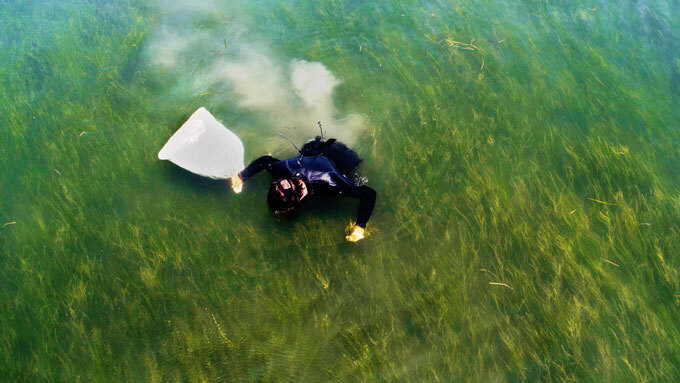Boosting Scotland's Coastal Ecosystem: Seagrass Restoration Bids

Table of Contents
The Ecological Importance of Seagrass in Scotland
Seagrass meadows are often referred to as the "blue forests" of the ocean, and for good reason. These underwater ecosystems provide a multitude of ecological benefits, contributing significantly to the health and resilience of Scotland's coastal environment. Their importance is multifaceted:
- Supports a high biodiversity of fish, invertebrates, and birds. Seagrass provides vital nursery habitats for commercially important fish species, shelter for invertebrates, and feeding grounds for numerous bird species. This biodiversity underpins the health of the wider marine ecosystem.
- Acts as a natural carbon sink, mitigating climate change. Seagrasses are remarkably efficient at sequestering carbon dioxide from the atmosphere, storing it in their sediments. This process plays a vital role in mitigating climate change and combating ocean acidification. Seagrass carbon capture is a key aspect of blue carbon initiatives.
- Stabilizes sediments, protecting coastlines from erosion. The dense root systems of seagrass meadows bind sediments, preventing erosion and protecting coastlines from storm damage. This natural coastal protection is increasingly important in the face of rising sea levels and more frequent extreme weather events.
- Improves water quality by filtering pollutants. Seagrass acts as a natural filter, removing pollutants and excess nutrients from the water column, improving water clarity and overall water quality. This enhances the health of the entire ecosystem.
The Current State of Seagrass in Scotland
Despite their ecological importance, Scotland's seagrass meadows are facing significant challenges. Decades of human activities have resulted in substantial losses, threatening the health of our coastal waters.
- Significant seagrass decline is observed in areas such as the Firth of Clyde, the Moray Firth, and the Solway Firth. These areas, once abundant with seagrass, have experienced considerable degradation due to various factors.
- Pollution from agricultural runoff, industrial discharges, and sewage impacts seagrass health. Excess nutrients lead to algal blooms, which can smother seagrass beds and reduce light penetration.
- Dredging, coastal development, and boating activities cause direct physical damage to seagrass meadows. The destruction of seagrass habitats through these activities significantly reduces their ability to function effectively.
- Existing legislation like the Marine (Scotland) Act 2010 aims to protect seagrass, but further action is needed to effectively address the multiple threats facing these vital ecosystems. Strengthening these regulations and enhancing enforcement are crucial for successful seagrass conservation.
The Role of Seagrass Restoration Bids
Addressing the decline of Scotland's seagrass requires significant investment and concerted effort. Seagrass Restoration Bids are crucial in securing the funding needed for effective restoration projects. These bids support various stages of restoration:
- Research: Understanding the specific challenges faced by seagrass in different locations is crucial for developing targeted restoration strategies. Bids fund scientific research into seagrass ecology and restoration techniques.
- Planting: Restoration projects involve various techniques, such as seed dispersal, transplanting seagrass shoots from healthy areas, and employing innovative technologies like drone-based seeding. Bids are essential to fund these large-scale planting efforts.
- Monitoring: Long-term monitoring is crucial to assess the success of restoration projects and adapt management strategies as needed. This involves regular surveys to track seagrass growth, biodiversity, and overall ecosystem health.
- Community Involvement: Successful restoration projects rely on the engagement of local communities. Bids can fund community education programs and volunteer initiatives.
Securing Funding for Seagrass Restoration
Securing funding for seagrass restoration requires a well-planned and compelling bid. This involves:
- Identifying funding opportunities: Numerous organizations offer grants for environmental projects, including government agencies (e.g., NatureScot), charities (e.g., The Marine Conservation Society), and private foundations.
- Writing compelling proposals: A successful bid clearly articulates the project's objectives, methodology, expected outcomes, and long-term sustainability. It highlights the ecological importance of seagrass and the broader benefits of the restoration work.
- Building partnerships: Collaboration between scientists, policymakers, local communities, and other stakeholders strengthens the bid and ensures project success. A strong collaborative approach demonstrates the wider commitment to seagrass conservation.
Community Engagement in Seagrass Restoration
Community involvement is paramount for the long-term success of seagrass restoration projects. Engaging local communities helps to raise awareness, build support, and ensure the sustainability of restoration efforts.
- Beach clean-ups: Removing litter and debris from coastal areas helps improve water quality and reduces threats to seagrass.
- Monitoring surveys: Volunteers can participate in seagrass monitoring programs, contributing valuable data for assessing restoration progress.
- Citizen science initiatives: Community involvement in data collection and analysis empowers local people to actively participate in seagrass conservation.
Successful community-led seagrass initiatives, such as those seen in other parts of the UK, demonstrate the power of collaborative action.
Conclusion
The vital role of seagrass in Scotland's coastal ecosystem cannot be overstated. The urgent need for seagrass restoration is clear, and Seagrass Restoration Bids represent a critical pathway to securing the necessary funding for these crucial projects. The success of these restoration efforts will depend heavily on effective collaboration, robust scientific understanding, and significant community engagement.
We urge individuals, organizations, and governmental bodies to learn more about seagrass restoration bids in Scotland, consider volunteering for a project, or supporting organizations dedicated to seagrass conservation. By actively participating in protecting and restoring Scotland's valuable seagrass meadows, we can ensure a healthier and more resilient coastline for generations to come. Let's champion further research and engagement in seagrass restoration and seagrass conservation bids for a brighter future for Scotland's seas.

Featured Posts
-
 Fox Sports Emmy Nominations Greg Olsens Triumph Over Tom Brady
May 05, 2025
Fox Sports Emmy Nominations Greg Olsens Triumph Over Tom Brady
May 05, 2025 -
 Nyc Filming Bradley Cooper Directs Will Arnett For Is This Thing On Exclusive Photos
May 05, 2025
Nyc Filming Bradley Cooper Directs Will Arnett For Is This Thing On Exclusive Photos
May 05, 2025 -
 Ufc 315 And May 2025 Fight Card Complete Schedule And Predictions
May 05, 2025
Ufc 315 And May 2025 Fight Card Complete Schedule And Predictions
May 05, 2025 -
 Ufc Kansas City Main Card Odds Breakdown And Predictions
May 05, 2025
Ufc Kansas City Main Card Odds Breakdown And Predictions
May 05, 2025 -
 How Much Do Lizzo Tickets Cost For Her 2024 Tour A Price Guide
May 05, 2025
How Much Do Lizzo Tickets Cost For Her 2024 Tour A Price Guide
May 05, 2025
